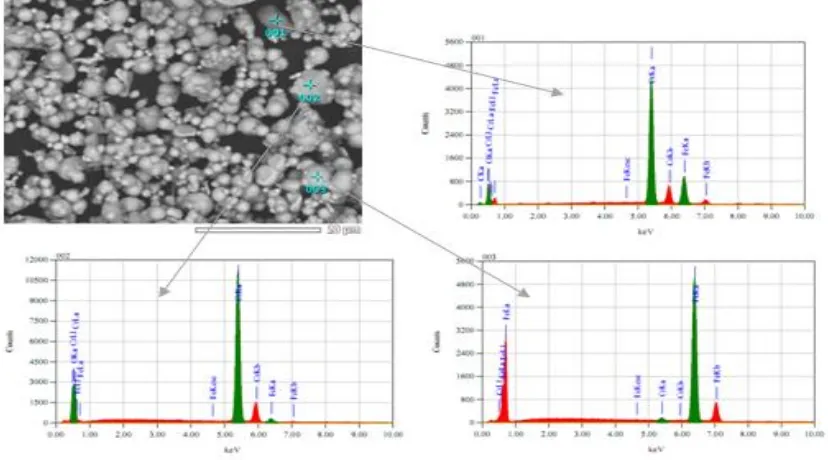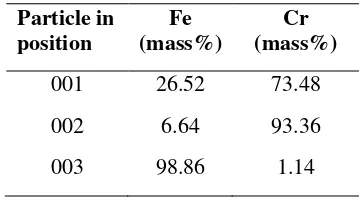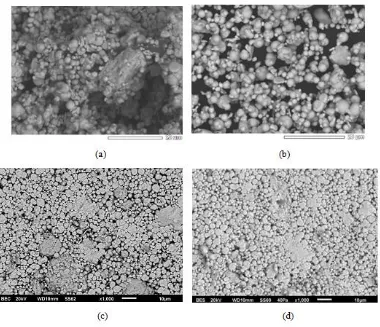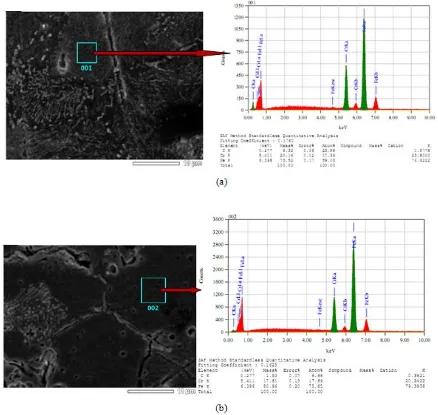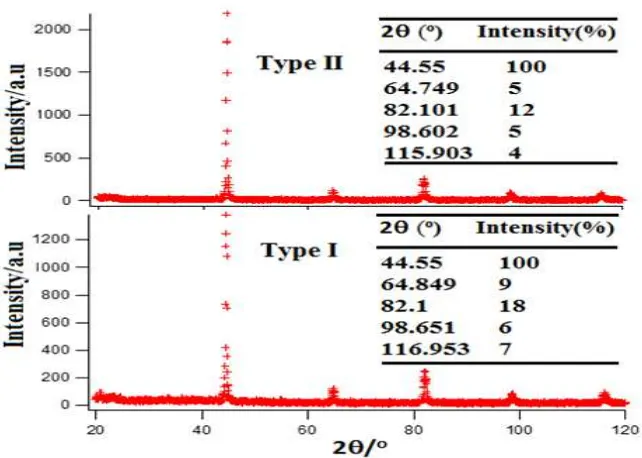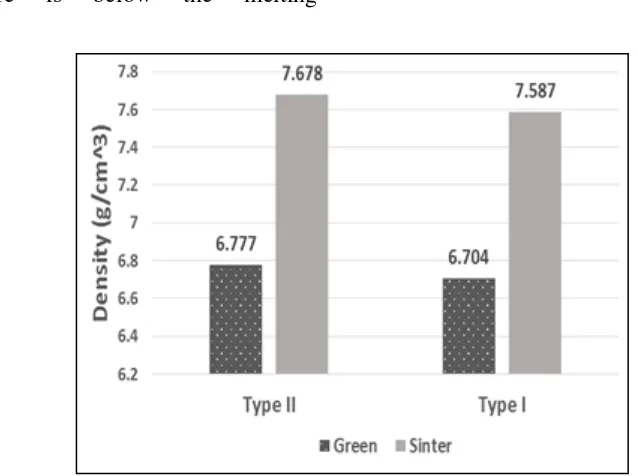ULTRASONIC TREATMENT EFFECT ON THE CONSOLIDATION OF
Fe-Cr PARTICLE MIXTURES AFTER COMPACTION AND
SINTERING PROCESS
Marzuki Silalahi1,2,*, Pudji Untoro2, Bambang Suharno1, Sri Harjanto1
1Metallurgy and Materials Engineering Department, Faculty of Engineering, Universitas Indonesia,
Kampus Baru UI Depok 16424, Indonesia
2Center for Technology of Nuclear Industry Material, National Nuclear Energy Agency,
Kawasan Puspiptek Serpong, Tangerang Selatan 15314, Indonesia E-mail : *[email protected]
Masuk tanggal : 18-06-2014, revisi tanggal : 04-07-2014, diterima untuk diterbitkan tanggal : 18-07-2014
Abstract
ULTRASONIC TREATMENT EFFECT ON THE CONSOLIDATION OF Fe-Cr PARTICLE MIXTURES AFTER COMPACTION AND SINTERING PROCESS. Fe-Cr microalloys which obtained by
ultrasonic method are the initial cores for the consolidation process. Therefore its facilitate the formation of the homogeneous bulk of Fe-Cr alloy with a stable phase. In this research, the synthesis of bulk of Fe-Cr alloy from the particles mixture of (Fe+Cr) as the ultrasonic treatment results has been carried out. The particles consolidation has been carried out through a process of compaction without adding any lubricants and followed by sintering process in the quartz glass capsules by using induction furnace at 1300 °C. Consolidation of mixture of Fe-Cr particles that have not undergone previous ultrasonic treatment is also made for a comparison. The investigation by using the SEM (scanning electron microscope)- and density measurements method were preformed on the Fe-Cr green powders compaction. The bulk of Fe-Cr alloys that are produced trough sintering process was observed using SEM-EDS (energy dispersive spectroscopy), XRD (x-ray diffraction), and density measurements method. The bulk of Fe-Cr alloy prepared with ultrasonically treated Fe-Cr microalloy powders, is more homogeneous in composition and has a better phase stability in comparison to Fe-Cr powders prepared without the ultrasonic treatment. Production of bulk Fe-Cr alloy in quartz glass capsule during the sintering process has produced Fe-Cr alloy without oxides.
Keywords : Ultrasonic, Fe-Cr miroalloy, SEM-EDS, XRD, Sintering, Density
Intisari
PENGARUH PERLAKUAN ULTRASONIK PADA KONSOLIDASI CAMPURAN SERBUK Fe-Cr SETELAH PROSES KOMPAKSI DAN SINTERING. Paduan mikro Fe-Cr yang diperoleh dengan menggunakan metode ultrasonik merupakan inti-inti awal untuk proses konsolidasi yang selanjutnya memfasilitasi pembentukan paduan Fe-Cr yang homogen dengan fasa stabil. Pada penelitian ini, telah dilakukan pembuatan bongkah paduan Fe-Cr dari partikel campuran (Fe+Cr) hasil perlakuan ultrasonik. Konsolidasi partikel-partikel dilakukan melalui proses kompaksi tanpa lubrikan dan diikuti oleh proses sintering pada temperatur 1300 oC dalam kapsul kaca kuarsa dengan menggunakan tungku induksi. Sebagai pembanding dilakukan juga konsolidasi terhadap campuran partikel (Fe+Cr) yang sebelumnya tidak mengalami perlakuan ultrasonik. Dilakukan pengamatan menggunakan metode SEM (scanning electron microscope) dan pengukuran densitas terhadap hasil kompaksi serbuk Fe-Cr. Pengamatan terhadap bongkah paduan Fe-Cr hasil proses sintering dilakukan menggunakan metode SEM-EDS (energy dispersive spectroscopy), XRD (x-ray diffraction), dan pengukuran densitas. Bongkah paduan Fe-Cr yang diperoleh dari serbuk paduan mikro Fe-Cr hasil perlakuan ultrasonik memiliki komposisi lebih homogen dan kestabilan fasa lebih baik dibandingkan dengan yang diperoleh dari serbuk Fe-Cr tanpa perlakuan ultrasonik. Pembuatan bongkah paduan Fe-Cr dalam kaca kuarsa selama proses sintering dihasilkan paduan Fe-Cr tanpa oksida.
Kata kunci : Ultrasonik, Paduan mikro Fe-Cr, SEM-EDS, XRD, Sintering, Berat jenis
INTRODUCTION
Fe-Cr is a Fe based alloy material that endures high-temperature conditions and
172 | Majalah Metalurgi, V 29.2.2014, ISSN 0126-3188/ 171-178 alloys, these are the melting[2], the powder
metallurgy- (P/M)[3], and the mechanical alloying (MA)[4] method. However, these alloying methods have intrinsic problems concerning homogeneity, oxidation and also that the processes are taking up a lengthy period of time to complete [5]. It is important to synthesize the Fe-Cr microalloy powders because the alloy powders with a homogeneous concentration is more resistant to oxidation than the alloys which are mixed with non-homogeneous concentration[6]; on the other hand alloy powders have a stable phase and have excellent mechanical properties[3]. Ultrasonic method could be utilized in the synthesis of homogeneous microalloys through the use of ultrasonic sound waves[7] and therefore could be utilized in the synthesis of homogeneous Fe-Cr microalloys[8]. The homogeneous Fe-Cr microalloy powders[9] synthesized
by ultrasonic treatment are expected to be
capable to overcome the limitations imposed by the current methods used in the synthesis of Fe-Cr alloys. This study is focused on the consolidation of the Fe-Cr microalloy particles produced by ultrasonic method through compaction without lubricant followed by sintering in quartz glass capsule by using an induction furnace.
EXPERIMENTAL METHOD Materials
The Fe-Cr microalloy powders prepared by ultrasonic treatment method[8] is used as
the basic materials (here labelled as type I), and Fe-Cr powders mixture which has been mixed in the mortar is then used for comparison (here labelled as type II). The precursors (Fe,Cr) are products of Aldrich Co. with a purity of 99.9 mass percentage. The mass percentage ratio of powders precursors (Fe:Cr) for both mixtures is 80:20.
Figure 1. Fe-Cr microalloy powders treated ultrasonically The precursor (Fe, Cr) powders were
immersed in a toluene liquid solution. The ultrasonic (Sonics, Power of 750 W, Ti Horn, 20 kHz) was then run at a frequency of 20 kHz and an amplitude of 40% of the maximum power. The process lasted up to 40 hours. The same process is repeated for Cr powder for up to 63 hours. Both of the
Ultrasonic Treatment Effect …../ Marzuki Silalahi | 173 Table 1. The designated particles composition of
Fe-Cr microalloy powders of Figure 1
Particle in microalloy powder of type I (ultrasonically prepared for 20 hours) and of the Fe-Cr of type II. Compacting of powders is executed by means of uniaxial compaction at 4 tons load in a cylindrical mold of 1.5 cm diameter. The true density of the Fe-Cr green powders is characterized with ASTM D4892-89 standard. After compaction process is completed, the compacted powders are inserted into a capsule made of quartz glass and the sintering process is completed in an induction furnace at 1300 °C for two hours, and then left to cool down to room temperature in the furnace. Characterization of the Fe-Cr green powders has been carried out using SEM (scanning electron microscopy)[10] method and density determination by using standard ASTM D 4892-89. The bulk of Fe-Cr alloys were prepared for microstructure observation by polishing and etching. Characterization was performed by using SEM-EDS (energy dispersive spectroscopy), XRD (X-ray diffraction)and density measurements.
Characterization
Characterization of the green powders has been carried out by using the SEM (JEOL JSM 6510, LA) apparatus to obtain the microstructure of the green of Fe-Cr. Density determination by using standard ASTM D 4892-89 by Helium gas penetration (ultrapyc 1200e, quantacrome)
to obtain the density of green Fe-Cr. The bulk of Fe-Cr alloys were prepared for
microstructure observation by polishing and etching. Characterization was performed by using SEM-EDS (JEOL, density measurements were carried out via the (ultrapyc 1200e, quantacrome) method.
Analysis
The characteristics of compact particles of Cr is obtained by analyzing the Fe-Cr inter particles in the microstructure of green of Fe-Cr. The green Fe-Cr density is compared to the density of the bulk Fe-Cr in order to obtain the effect of the sintering process on the sample. The characteristic of bulk Fe-Cr is obtained by analyzing the grain morphology of the microstructure and the Fe and Cr elements composition experimental lattice parameters are obtained by calculating the values of the interplanar distance d (for BCC structure)[11] corresponding to the 2 reflection angles of the XRD diffraction patterns. The lattice parameters obtained by manual calculation is compared to the theoretical values of the lattice parameters predicted by Vegard Law.
RESULTS AND DISCUSSION
174 | Majalah Metalurgi, V 29.2.2014, ISSN 0126-3188/ 171-178 and type II Fe-Cr alloy, the particles are
separated or detached from each other. The type II sample consists of small and large
particles, on the other hand the type I sample has a homogeneous shape and particles size.
Figure 2. Microstructures of Fe-Cr (a) powders of type II, the mixture in a mortar,(b) powders of type I, treated
ultrasonically for 20 hours, (c) green compaction of Type II, and (d) green compaction of Type I
As shown in Figure 2(c), the green sample of type II consists of small and large (Cr agglomeration) particles, the particle agglomeration has a higher density than the green of small particles, and also the small and large particles are complementary to each other, thus the density of the type II sample is increasing. On the other hand, the particles which form the type I sample are the homogeneous small particles, some of these particles are fractional constituents of the Cr agglomeration and these particles
are not complementary to one another, so the density of green type I sample remains low.
The microstructure and elemental compositions of the bulk of Fe-Cr alloys of the sintering process results are shown in Figure 3. As in Figure 3, both of the type II and type I bulk of Fe-Cr alloys have the clearly defined grain boundaries outline and homogeneous particles. Both are well-compacted and show some porosity on the surfaces and in the boundaries and have polygon shaped grains.
Ultrasonic Treatment Effect …../ Marzuki Silalahi | 175 the following elements, namely (in %mass)
73.52 % Fe and 20.16 % Cr, while in the type I sample the composition breakdown is 80.16 % Fe and 17.61% Cr. The composition of the elements contained in the type I sample is closer to the initial
composition of the constituents, in other words, the composition of the bulk Fe-Cr alloy prepared with the ultrasonically treated precursor is more homogeneous than the bulk Fe-Cr alloy prepared with nonultrasonic precursors.
Figure 3. The microstructures and elemental compositions of the bulk of fe-Cr alloys as the results of sintering
process of green powders of Fe-Cr, (a) Type II, (b) Type I
As is shown in Figure 2(d), some particles of green of type I sample are Fe-Cr microalloy particles (strong metal bonding[13]) therefore, during the sintering
process the Fe or Cr particles that exist around the Fe-Cr microalloy particles would diffuse more easily toward the Fe-Cr microalloy particles and complete the composition. On the other hand, the
agglomeration of Cr particles contained in the green of type II sample is a large particle, so there would be more residual particles in it that have not yet diffused than in the type I samples. The formation of Fe-Cr alloys in both samples is in agreement with previous studies [14-15].
176 | Majalah Metalurgi, V 29.2.2014, ISSN 0126-3188/ 171-178 in Figure 4. The lattice parameters of Fe
and Cr obtained by manual calculation of the measurements are listed in Table 2.XRD diffraction intensity
Figure 4. Diffraction patterns accompanied by peak position 2 of bulk of Fe-Cr Table 2. Lattice parameter values a of precursors of Fe and Cr and of Vegard’Law
From Figure 4 it is apparent that the diffraction patterns of both bulk of Fe-Cr type II and I samples are similar, both have single reflection peaks with 2 position as presented in the labeled table of Figure 4. The lattice parameter for the type II bulk Fe-Cr alloy is found to be 2.873 Å, and of type I it is 2.872 Å. Thus the lattice parameter values were found to lie between the two (Fe and Cr) manually calculated aXRD experimental values as
shown in Table 2, therefore according to Vegard’s Law[12], these alloys are in the
Fe-Cr phase. The Fe-Cr alloys lattice parameter values after sintering, are close to the value obtained by calculation using Vegard’s law (2.871 Å, as presented in Table 2), and this value is closest to the lattice parameter value of Fe-Cr alloy of
type I. These results confirm that the powders of Fe-Cr microalloy treated ultrasonically is more consistent in the establishment of phase of a bulk of Fe-Cr alloy compared with the powders of Fe-Cr without ultrasonic treatment. The diffraction patterns of Figure 4 also show that the process of consolidation by compaction and followed by sintering in quartz glass capsule is the process with no oxide formation. With the sintering process also produces solid solution alloy according to the theory provided by the Hume-Rothery rules[16-17].
Ultrasonic Treatment Effect …../ Marzuki Silalahi | 177 follows the solid state material transport
mechanism[18], wherein the sintering temperature is below the melting
temperature of the forming particles of Fe-Cr alloys.
Figure 5. The increase in density of green of Fe-Cr after sintering
CONCLUSION
Synthesis of bulk of Fe-Cr alloy can be accomplished by consolidation of Fe-Cr microalloy particles treated ultrasonically through compacting process without additional lubricants and followed by sintering process at 1300 °C. The bulk of Fe-Cr alloy composition synthesized with Fe-Cr microalloy particles treated ultrasonically is more homogeneous than the sample synthesized with Fe-Cr particles without the ultrasonic treatment. The powders of Fe-Cr microalloy treated ultrasonically is more consistent in the establishment of phase of a bulk of Fe-Cr alloy compared with the powders of Fe-Cr prepared without the ultrasonic treatment. After sintering, the increase in the density of green of Fe-Cr prepared with the ultrasonically treated microalloys powder is lower than the density of Fe-Cr with powders prepared without the ultrasonic treatment. The synthesis of bulk of Fe-Cr alloy in quartz glass capsule during the sintering process has produced the Fe-Cr alloy without oxides.
REFERENCES
[1] Willem, J.Q., Piron-Abellan, J., Vladimir, S. 2004. ,,Metallic Materials in Solid Oxide Fuel Cells”.
Materials Research, vol. 7, no. 1, pp.
203-208.
[2] Shen, J., Xhou, L., Li, T. 1998. ,,Effects of Surface-Applied Ceria on The Stability of Thermally Growing Chromia Scale of FeCr Alloys and 310 Steel”. Journal of Materials Science 33, pp.5813-5819.
[3] Shigeru Unami, Satosi Uenosono, Junichi Ohta. 2002. ,,Cr-Alloyed Steel Powder for High-Strength Sintered Parts without Heat Treatment after Sintering”. Kawasaki Steel Technical Report, No. 47
December, pp.55-59.
[4] Darwin, S., Deni, S. K., Saryanto, H, Sulaiman, H., Othman, M.A., and Pudji, U. 2010. ,,Oxidation Resistance of Fe80Cr20 Alloys
178 | Majalah Metalurgi, V 29.2.2014, ISSN 0126-3188/ 171-178
Proceedings, volume 1394, pp.
90-102.
[5] Suñol J.J., González A., Saurina J., Escoda L., Pradell T., Clavaguera-Mora M.T and Clavaguera N. 2004.
Materials Science and Engineering A
375, 88.
[6] Arvidsson J. 1998. Proceeding of
The PM World Conference, Granada,
Spain
[7] Suslick, K.S., Cline, R.E. and Hammerton,D.A. 1986. Journal of the American Chemical Society, 108,
5641.
[8] Silalahi Marzuki, Dimyati Arbi, Harjanto Sri , Untoro Pudji, Suharno Bambang. 2014. ,,Microalloying of Fe-Cr by Using Ultrasonic Irradiation”. International Journal of Technology Vol 5, No.2 :169-182.
[9] Annamalai A. Raja, Upadhayal A. and Agarwal D. 2011.,,Effect of Heating Mode on Sintering of Ferrous Compacts Through Powder Metallurgy Route”. International
Heat Treatment and Surface
Engineering 2011, vol 5, No 4, pp
155-160.
[10] ASM Handbook. 1996.,,Materials Characterization”. Vol 10 of the 9th
Edition Metals Handbook, American Society for Metals, Washington D.C
[11] ICDD, Software PCPDFWIN VERSION 1.30 (C) Copyright 1997. [12] Cullity B. D. 1998.,,Introduction to
X- Ray Diffraction”. Prentice Hall, London.
[13] Kim J. C., Auh K. H., and Martin D. M. 2000. ,,Multi-level Particle Packing Model of Ceramic Agglomerates”. Modeling and Simulation of Materials of Science and Engineering, vol. 8, pp.
159-168.
[14] De Jonghe Lutgard C. and Rahaman Mohammed N. 2003. ,,Handbook of Advanced Ceramics: Sintering of Ceramics”. Elsevier, pp. 187.
[15] ASM Handbook. 1998.,,Powder
Metal Technologies and
Applications”. Vol 7, American
Society for Metals, Washington D.C. [16] Mayo M. J.. 1996. ,,Processing of
Nanocrystalline Ceramics From Ultrafine Particles”. International Materials Reviews, vol. 41, no. 3, pp.
85-115.
[17] Abbhaschian Reza, Abbhaschian Lara, Reed-Hill Robert E. 2008.,,Physical Metallurgy Principles”. Fourth edition, Cengage Learning, pp 261-267 .
